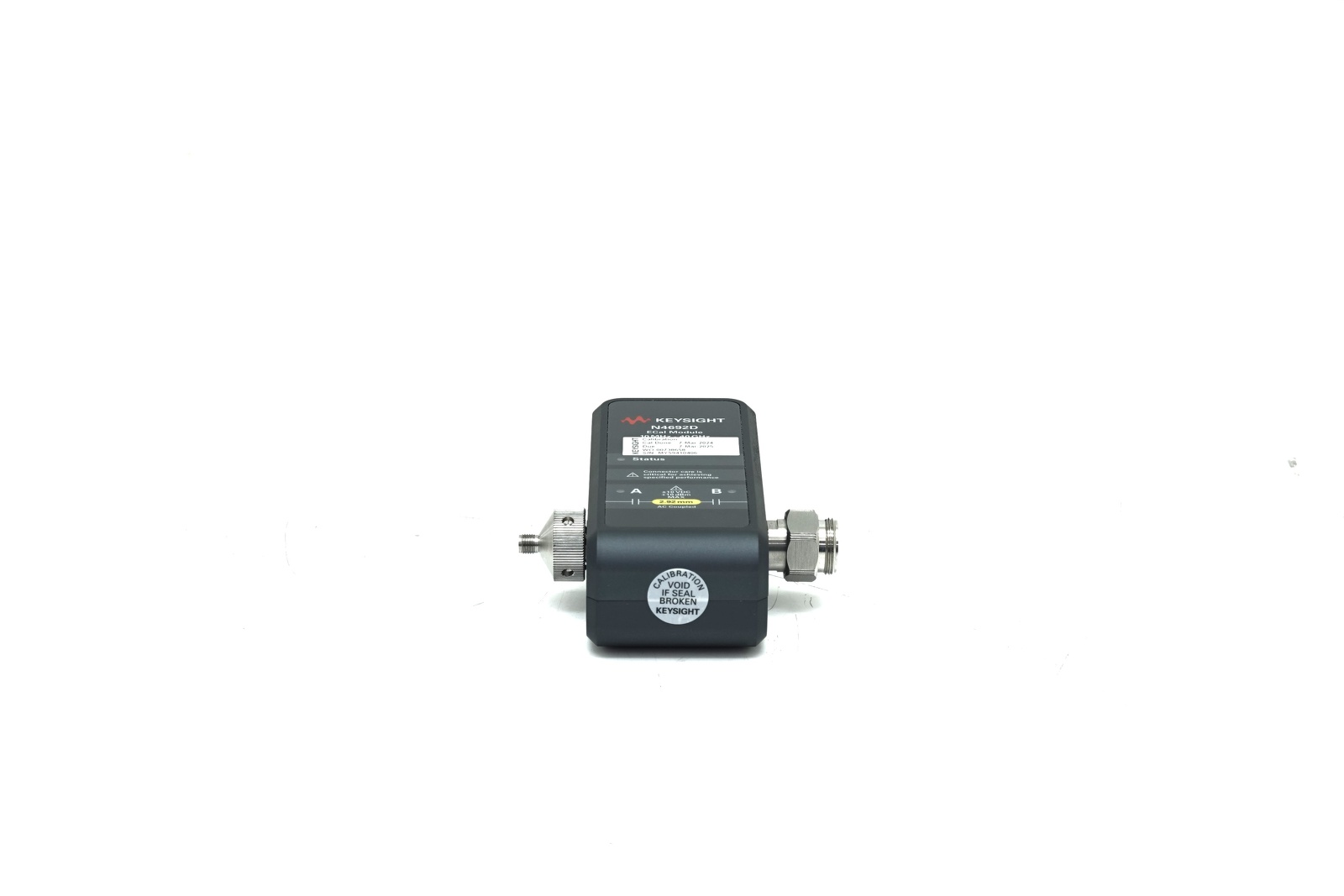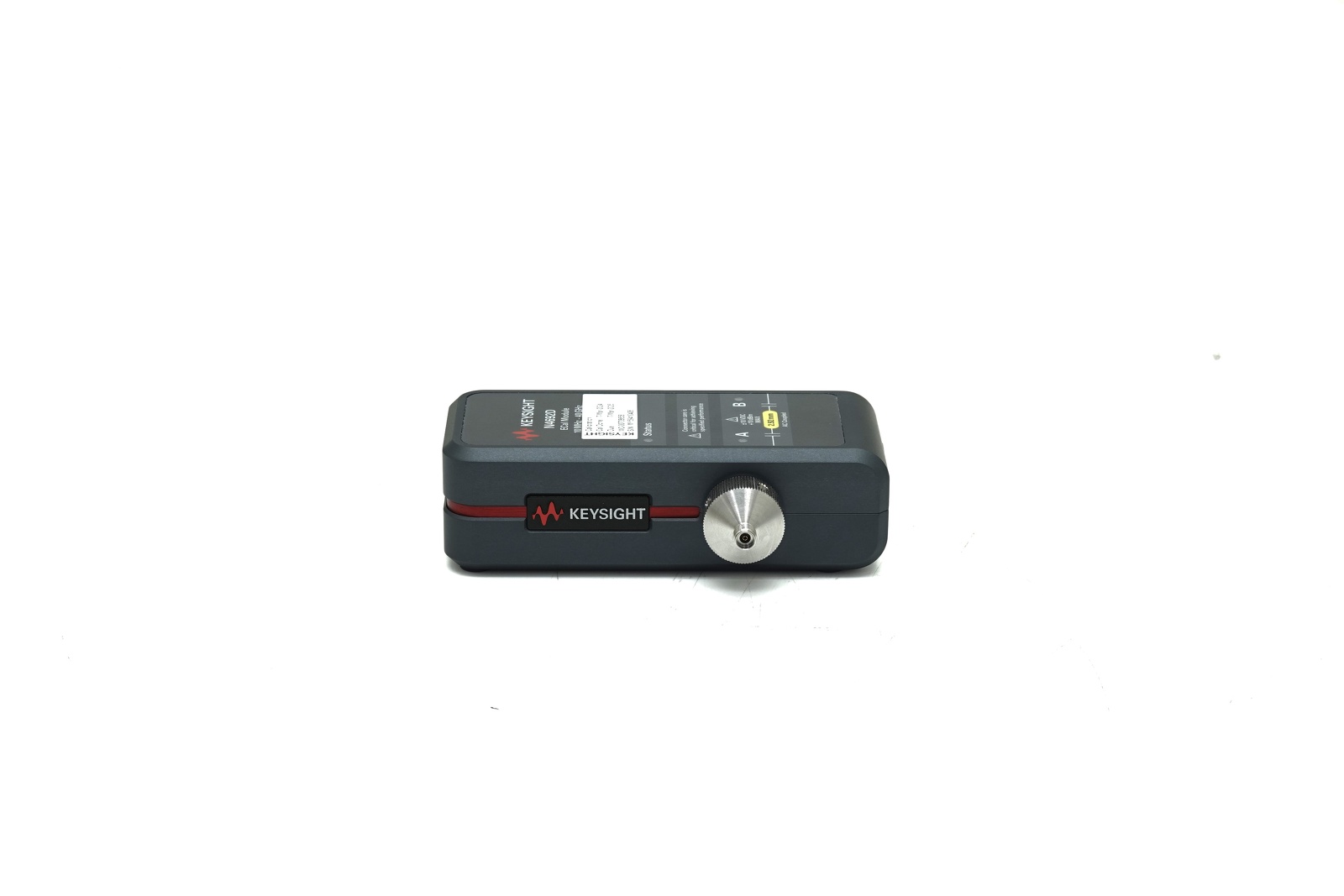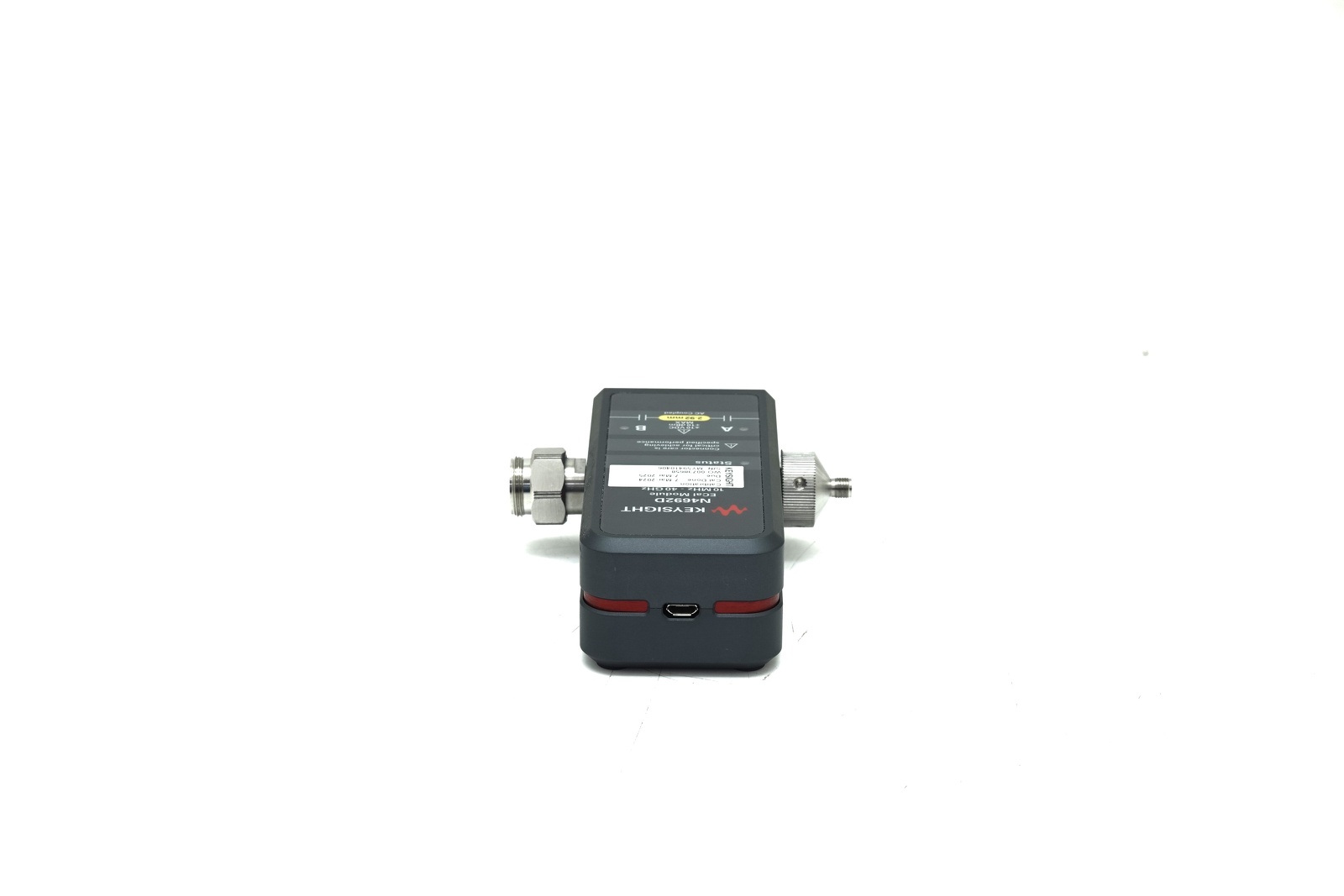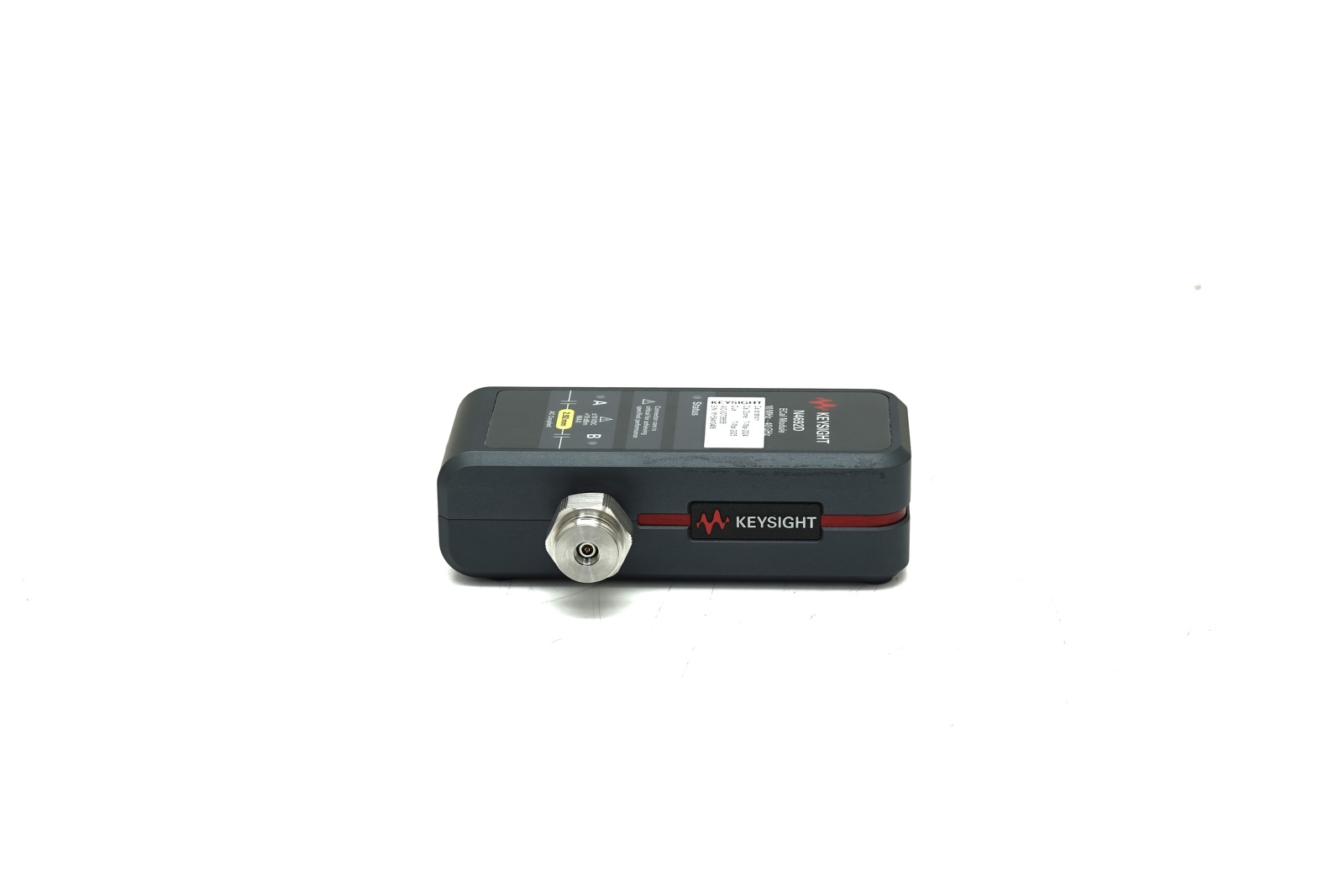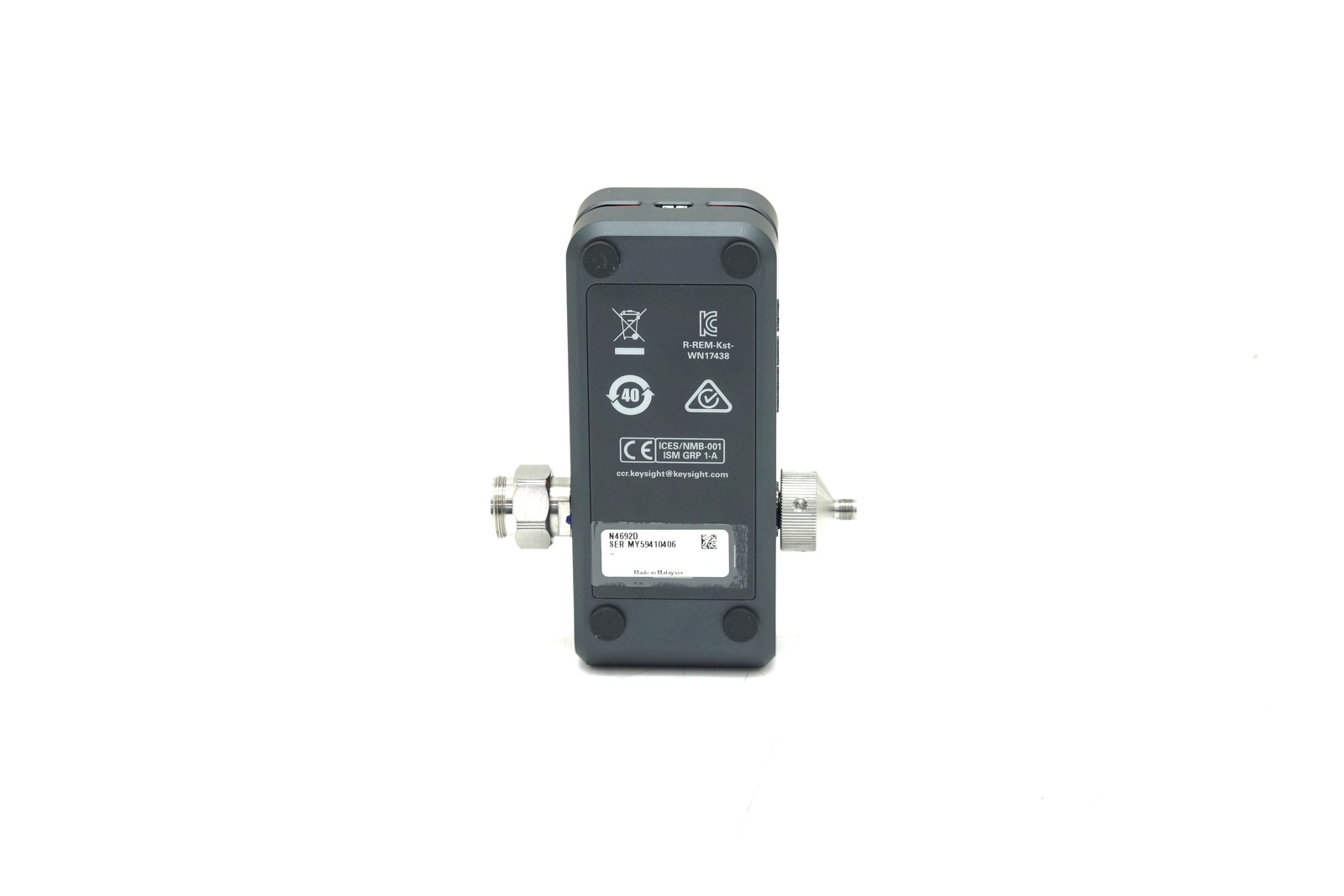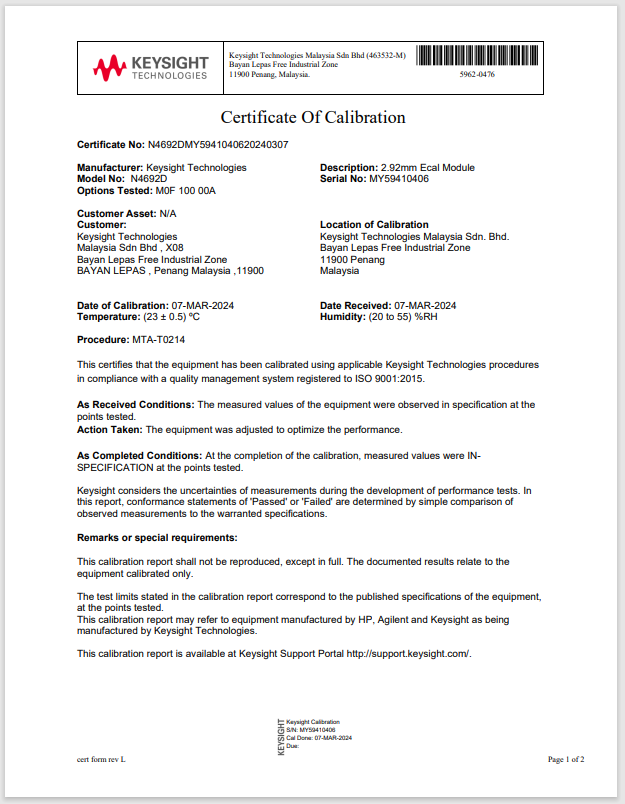Do you need help?
Contact us with any question regarding your used Keysight equipment purchase!

Product selection and configuration assistance
Availabilty, warranty extensions, calibration plans, additional software options, education discounts etc.
Keysight N4692D
Electronic Calibration Module (ECal) / 2-port / 2.92mm
Cannot ship to:
European Union
Switzerland
Norway
Turkey
Unit only ships within China.
Unit ships worldwide.

Keysight Used
Keysight N4692D
From
USD 8,912.00 Save 68%
Installed Options
| 100 | 10 MHZ TO 40 GHZ |
| M0F | ONE FEMALE AND ONE MALE CONNECTOR, BOTH 2.92 MM |
Product Specifications
- Precision 2-port microwave ECal module with high accuracy
- Fast, easy, and accurate full two-port calibration
- Supports 2.92 mm connectors
- Available in male/male (option M0M), female/female (option F0F), and male/female (option M0F) connector configurations
- Direct control from Keysight vector network analyzers via USB
The Keysight N4692D microwave electronic calibration (ECal) module makes calibration of Keysight vector network analyzers fast, easy and accurate. Select either female-female, male-male, or female-male connectors. The plastic storage case for the N4692D is included for securing your ECal module and accessories.
The N4692D Option 0DC extends the calibration frequency range down to DC, which is beneficial for broadband device modeling or time domain and signal integrity analysis using enhanced time domain-analysis on the Keysight network analyzers.
This ECal module is an ideal solution for calibrating vector network analyzers. Performing a full two-port calibration takes less than half the time and number of connections versus traditional mechanical cal kits. The operator simply connects the ECal module to the vector network analyzer via USB and the firmware controls the rest, thus reducing the chance for operator error. Wear and tear on connectors is reduced as well, lowering repair costs on both the test port connectors and calibration standards.
Accessories
Accessories only included if shown in the pictures.
Other accessories that are not listed and included in the offer can be purchased separately at an extra cost with your purchase of a Keysight Used or Keysight Premium Used unit. Please specify in the comment field which additional accessories or support you are interested in.
For separate or post-purchase ordering, please contact your local Keysight office or Keysight Partner here. Or check our online store if available for your region here.
Ready To Get Started?
Similar Listings
This Model
Other Listings
FAQs
What are the main differences between Keysight New, Keysight Premium Used & Keysight Used equipment?
| Keysight New | Keysight Premium Used | Keysight Used | |
|---|---|---|---|
| Savings | None | Up to 70% | Up to 90% |
| Condition | New | Like New | Working Condition ¹ |
| Firmware | Latest | Updated | As is |
| Calibration | Full | Full | As listed |
| Accessories | New | New | As listed |
| Warranty | 1 to 5 Years ² | Like New | 90 Days Warranty |
| Customization | Possible | Possible | Limited |
Learn more about Keysight Premium Used Here
Can I configure a unit to meet my personal needs?
Customization is generally possible with our Keysight Premium Used equipment. The majority of our Keysight Premium Used equipment can be configured just the way you need it. Options can be added at additional cost.
Customizing Keysight Premium Used equipment might change the delivery and lead time of the item.
Some Keysight Used products cannot be customized. Use the contact option on the product page to check with the our eStore team.
What accessories are included?
Keysight Premium Used equipment typically comes with the same accessories and warranty as new products.
Can you include other accessories?
We currently only offer those accessories which are part of the listing. Other accessories can be purchased separately at extra cost with your purchase of a Keysight Used or Keysight Premium Used unit.
Please mention in the comment field which additional accessories or support you are interested in.
For seperate or post-purchase ordering, please contact your local Keysight office or Keysight Partner here. Or check our online store if available for your region here.
Get an Account and Keep Track of Models, Prices, and Availability
Education
and Non-profit Customers Can Save Extra
Network + Impedance Analyzers Quick-Facts
What is a Vector Network Analyzer?
High-performance Vector Network Analyzers (VNA) are used to characterize and analyze RF and Microwave devices such as amplifiers, filters, power dividers/combiners, switches, antennas, and more. VNAs provide engineers with accurate device measurements including S-parameters, noise figures, return loss, and more.
What is a Vector Network Analyzer used for?
A Vector Network Analyzer, a stimulus response testing equipment, is commonly used for research and development, design validation, failure analysis, and production testing by measuring the frequency response of component(s).
Does a VNA need to be calibrated?
Yes, all VNAs are calibrated to ensure the highest quality results. The calibration process involves adjusting the instrument to eradicate the hardware systematic errors using traceable standards for accuracy and phase measurements.
How do you calibrate a Vector Network Analyzer?
The calibration process can be done manually or automatically, but in most cases, the manual method is used. The common methods of calibration include SOLT and TRL based on different parameters to remove systematic errors. Manual calibration involves selecting a known stimulus signal from a list of available signals within the VNA's software, then adjusting the amplitude and phase until the value corresponds to that from the known stimulus source. The network analyzer should be periodically calibrated with a reference calibrator to ensure the analyzer is measuring correctly. Periodic calibration guarantees the match with International standards.
Does a VNA have error correction?
Some VNAs have built-in error correction that may compensate for a variety of errors including thermal drift, time delay, source-load mismatch and optical path length variations.
What is the difference between a Vector Network Analyzer vs Network Analyzer?
A Vector Network Analyzer measures the amplitude as well as phase characteristics of one and two-port devices such as wireless components, microstrip lines, and branched structures.
A Network Analyzer measures the network parameters of two-port and arbitrary number of ports devices such as amplifiers, filters etc.
What is the difference between a Vector Network Analyzer vs Spectrum Analyzer?
A Vector Network Analyzer measures complex component specifications at specific frequencies using a signal generator and a receiver.
A Spectrum Analyzer measures power across an entire frequency spectrum of the applied signal using a receiver only.
What is the difference between a Vector Network Analyzer vs Oscilloscope?
An oscilloscope measures external signals by representing voltage waveforms as a function of time, while a Vector Network Analyzer measures both the amplitude and phase monitoring the response of a network.
How does a VNA measure S11?
A VNA measures S11 by introducing a stimulus signal into the port of the device being tested, then measuring the reflected signal. The frequency at which this reflection occurs is then used to calculate S11.
What is the S21 parameter?
S21 is used to measure how well a device rejects signals that are passed through the input port and reflected on the output port. The power transferred from the first port to the next can be determined using the S21 parameter.
What are propagation and channel modeling?
Propagation and channel modeling is a technique for estimating the performance of wireless communications antennas and their effect on cell coverage.
The most significant parameters in propagation and channel modeling are path loss, Fresnel zone, path attenuation, and multipath fading.
What is a Smith chart?
A Smith chart is a graphic representation of a particular type of circuit operation. It shows the impedance, admittance, and conductance of an amplifier or other system component as it relates to frequency or voltage. In order to understand how a Smith chart operates, it is important to know the basics of transmission line theory.
What is Voltage Standing Wave Ratio?
Voltage standing wave ratio is the measure of the non-reactive voltage received at a point in space relative to cause by an AC source, thus representing the reflected power from the antenna source. It is typically specified as volts per meter (V/m) or millivolts per meter (mV/m).
How does a Vector Network Analyzer measure phase?
A Vector Network Analyzer measures phase by introducing a stimulus signal into the port of the device being measured. The degree of phase shift is then noted. A separate calibration is used to determine the degree of phase shift when no stimulus signal is applied.
How does a VNA measure amplitude?
A VNA measures amplitude by introducing a stimulus signal into the port of the device, then measuring the strength. The magnitude of the reflected signal is then used to calculate amplitude.
What are amplitude properties?
Amplitude properties include the amplitude at a particular frequency, amplitude ranges, amplitude linearity, and amplitude ratio measurements.







